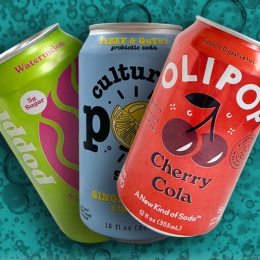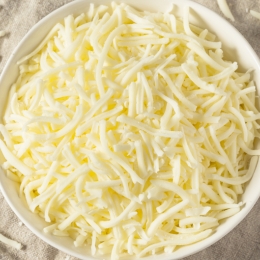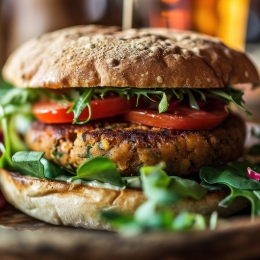What's in the best smoothies & shakes
This article comes from Nutrition Action. We don't accept any paid advertising or corporate or government donations. Any products we recommend have been vetted by our staff and are not advertisements by the manufacturers.
At shops like Jamba Juice, most smoothies aren’t just fruit plus milk or yogurt. They often contain sugary sherbet, juice, lemonade, frozen yogurt, etc. So even the smallest sizes typically start at 250 to 400 calories. In other words, they just can’t beat the smoothies you whip up at home. Here’s our DIY 8-step guide.
Short on time, or on the go? We've also picked out some of the best bottled smoothies and shakes (scroll down for those).
How to blend a healthier smoothie at home
1. Start with frozen fruit.
It’s a quick route to an icy, refreshing smoothie. Berries, cherries, mango, pineapple, peaches, bananas, you name it...all fruits are good fruits. And frozen fruits are just as rich in vitamins and minerals as fresh.

Aside from packs of sweetened açaí berry purée and tubs of sugary sliced strawberries, added sugar is rare in the frozen-fruit case. You won’t find any in our frozen Best Bites (see our chart, below). Bonus: Frozen fruit is ready when you are, it’s food-waste-proof, and it’s also at home in your yogurt or cereal bowl.
2. Blends make it easy.
To make your smoothie prep a snap, grab a frozen fruit blend. See the photos in this section for some of our favorites...or let them inspire your own combos.

3. Want vegetables?
Add your own (see No. 8 below). Most frozen fruit-and-vegetable blends don’t add many veggies. For example, Dole Fruit & Veggie Fruit ‘n Greens has more mango, banana, apple, and pineapple than spinach, the Berries ‘n Kale has more strawberries, banana, and blueberries than kale, and the Tropical Avocado with Kale has more banana, pineapple, and mango than avocado or kale.
Do you need vegetables in a smoothie? Nope. But if you bought a blend for its veggies, you may be underwhelmed.
Food-safety tip: Skip frozen vegetables (like spinach, carrots, or kale) if they come with heating instructions on the package. That means they’re not intended to be eaten without cooking.
4. Skip the juice.

Fruit is healthier than juice, so blend your real fruit and/or veggies with another liquid (see No. 5).
It’s not just that juice has no intact fiber (it often has no fiber at all). The concentrated dose of fruit sugars in juice also boosts a smoothie’s calorie density—the calories per swallow.
And keep in mind that neither juice nor smoothies may curb your appetite like whole fruit. Studies show that when people drink—rather than chew—their calories, they’re unlikely to fully compensate by eating less food later. Over time, that can lead to unhealthy weight gain.
5. Pick a lower-sugar liquid.
If you’re aiming for a lower-calorie snack, blend your fruit with water or unsweetened nut milk.
Want more sweetness? Add banana. Or try a splash of coconut water. It has half the calories of other juices (50 per cup), yet as much or more potassium than most. And unlike coconut milk, it’s free of saturated (unhealthy) fat.

Looking for more protein and calcium? Use fat-free or 1% dairy milk or a fortified soy or pea protein plant milk like unsweetened or original Ripple or Silk Protein. Or go with a plain or lower-sugar kefir (scroll down) or yogurt.
6. Go green.
A do-it-yourself smoothie isn’t just good for you. It also eliminates a bottled smoothie’s thick plastic, which rarely gets recycled.
Another way to minimize excess packaging: Buy larger bags of frozen fruit. And skip frozen blends that come in individually portioned bags, like Dole Crafted Smoothie Blends.
Or go greener: Freeze your own smoothie ingredients in reusable containers.

7. Cut food waste.
Got fresh bananas, berries, or other fruit on the verge of spoiling? Slice or wash them (if needed), then freeze. Ta-dah! A future smoothie awaits.
8. Want more?
Blending your own smoothie? For extra nutrients, try:
- Chia or hemp seeds. A tablespoon adds a bit of fiber (chia) or plant protein (hemp), plus minerals.
- Baby kale. Keep a bag in the fridge for salads, sides, and smoothies. Kale beats spinach because the oxalates in spinach bind to the calcium in milk or yogurt, so you absorb less of it.
- PB2. Nut butters are full of healthy fats, but each 100-calorie spoonful adds up. Not so with PB2, a powder made of peanuts that have been pressed to remove most of their oil. Each tablespoon has 30 calories, a mere half gram of added sugar, and plenty of nutty flavor. PB2-banana smoothie, anyone?
Some of the best (and worst) bottled smoothies & shakes
Yogurt & kefir smoothies

Cultured dairy drinks don’t have much fruit, but they do deliver a smoothie with calcium and potassium in one easy pour. Some highlights:
- Chobani Complete Shake. The super thick, creamy Best Bite has 25 grams of protein, 25 percent of a day’s calcium, and 10 percent of a day’s potassium, all for only 200-or-so calories per 10 oz. bottle of drinkable yogurt. Impressive!
- Lifeway Kefir. The “champagne of dairy” tastes like a pleasantly tangy sip of yogurt. All of Lifeway’s 0% and 1% kefirs get either Best Bites (plain) or Honorable Mentions (flavored). None top our added-sugar limit of 9 grams (2 teaspoons) per 8 oz.
- Siggi’s Probiotic Drinkable Nonfat Yogurt. Like kefir, it’s a yummy, tangy winner for dairy drinkers. (For more on probiotics in yogurt, see our guide to yogurt.)
Looking for plant-based smoothies? We didn’t find any Best Bites or Honorable Mentions. Siggi’s Plant-Based Probiotic Coconut Drink has 8 grams of (pea) protein—rare in the cultured plant-based aisle. And taste-wise, it’s a convincing dairy dupe. But with 4½ grams of saturated fat per cup—more than our two-gram limit—it’s close to a whole-milk yogurt drink. And since it’s dairy-free (and unfortified), there’s little calcium or potassium.
Protein shakes

Perusing protein shakes? Some pointers:
- Milkshake in disguise? “Protein” is a health halo that sells sugar-loaded drinks like Bolthouse Protein Plus, with up to 23 to 37 grams (5½ to 9 tsp.) of added sugar per 15.2 oz. shake. Naked’s same-size Chocolate and Vanilla Protein almondmilk smoothies hit 46 grams (11 tsp.)—just 1 teaspoon shy of a day’s max!
- Less sugar. Honorable Mentions Evolve, Koia Protein, Owyn, and Silk Ultra Original have just 1 tsp. added sugar per bottle or cup.
- Risky sweeteners. Special K Protein, Fairlife, and some others add low-calorie sweeteners like sucralose and acesulfame potassium, which we rate as “Avoid” (see chemicalcuisine.org).
- Chicory caution. Processed chicory root fiber (aka inulin) is in lower-sugar protein shakes like Koia Protein and Iconic (and in some yogurt ones like Chobani). It’s safe, but it gives some people gas.
- “Keto” decoded. It usually means no added sugar, but coconut milk and MCT oil can add a half to a full day’s saturated fat.
Need it? Do you need the 20-plus grams of protein—40 percent of a day’s worth—in many shakes? Not if it’s just a snack. Our Best Bites and Honorable Mentions have at least 8 grams of protein per cup—what you’d get in a yogurt smoothie. That may be plenty for you.
Juice smoothies

We didn’t give juice-plus-purée smoothies Best Bites or Honorable Mentions because they’re heavy on juice and not as healthy as they look. Take Bolthouse Blue Goodness:
- “No sugar added.” True, but a 15.2 oz. bottle still squeezes in 52 grams (12½ tsp.) of juice-plus-purée sugars and 280 liquid calories.
- “3 ¾ servings of fruit.” That’s no surprise, since ½ cup (4 oz.) of juice counts as a serving, says the U.S. Department of Agriculture. But juice doesn’t curb your appetite like whole fruit.
- 11 grams fiber. Much of it comes from processed dextrin and chicory root. They can’t match the intact fiber in whole berries. (Blue Goodness only has berry juice, not berries.)
- Nutrient-poor apple juice. The smoothie’s first ingredient: apple juice from concentrate. Not that you could tell from the picture on the front of the bottle, of course. The apple is largely hidden behind a pile of berries...with no sign of the second ingredient (banana purée).
Our chart of Best Bites, Honorable Mentions, and more
Frozen fruit blends: Best Bites have no added sugar and no more than 2 grams of saturated fat per serving.
Smoothies & shakes: Best Bites have no added sugar. Honorable Mentions can have up to 2 teaspoons per cup (8 oz.). Both also have at least 8 grams of protein and no more than 2 grams of saturated fat per cup.
We disqualified shakes with acesulfame potassium or sucralose. We also disqualified all juice smoothies. (Why? See No. 4 above.)
Tags
Topics
Continue reading this article with a NutritionAction subscription
Already a subscriber? Log in
More shopping guides
Store-bought pre-seasoned tofu: Which is best?
Healthy Eating

How to find a healthy ice cream bar or frozen treat
Healthy Eating

Can sodas help your gut health?
Healthy Eating

How to find a healthy dairy or plant-based cheese
Healthy Eating

How to choose the best plant-based burgers & beyond
Healthy Eating


